Welser family

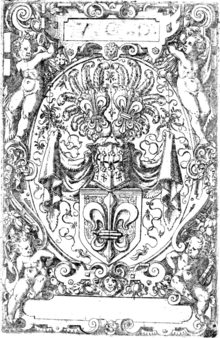
Welser was a German banking and merchant family, originally a patrician family based in Augsburg and Nuremberg, that rose to great prominence in international high finance in the 16th century as bankers to the Habsburgs and financiers of Charles V, Holy Roman Emperor. Along with the Fugger family, the Welser family controlled large sectors of the European economy, and accumulated enormous wealth through trade and the German colonization of the Americas, including slave trade. The family received colonial rights of the Province of Venezuela from Charles V, who was also King of Spain, in 1528, becoming owners and rulers of the South American colony of Klein-Venedig (within modern Venezuela), but were deprived of their rule in 1546. Philippine Welser (1527–1580), famed for both her learning and her beauty, was married to Archduke Ferdinand, Emperor Ferdinand I's son.[1][2]
Claiming descent from the Byzantine general Belisarius, the family is known since the 13th century. By the early Age of Discovery, the Welser family had established trading posts in Antwerp, Lyon, Madrid, Nuremberg, Sevilla, Lisbon, Venice, Rome, and Santo Domingo. The Welsers financed not only the Emperor, but also other European monarchs. After the Reformation, both Welser and Fugger families remained in the Roman Catholic Church.[3]
History[edit]
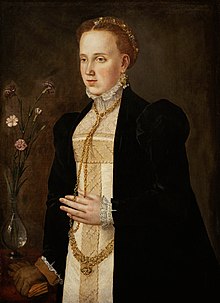
The history of the family can be traced back to the 13th century, when its members held official positions in the city of Augsburg. Later, the family became widely known as prominent merchants. During the 15th century, when the brothers Bartholomew and Lucas Welser carried on an extensive trade with the Levant and elsewhere, they had branches in the principal trading centres of southern Germany and Italy, and also in Antwerp, London, and Lisbon.[4] In the 15th and 16th centuries, branches of the family settled at Nuremberg and in Austria. They were represented in the inner council by the Dance Statute of Nuremberg.
The business was continued by Antony (died 1518), a son of Lucas Welser. He was one of the first Germans to use the sea route to the East, which had been discovered by Vasco da Gama.[4]
Contribution to Colonization in the Americas[edit]
Contrary to many historiographical depictions, the conquest of the Americas would not have been as successful as it was without the help of many other foreign actors, such as the Welser Family. Historian Julia Roth claims that a “relational perspective” on the Welser Family's contributions to the colonization of the Americas explains how the Welsers have continued to be an example for other “German colonial endeavors and fantasies.”[5]
The Welser Family saw its chance to participate in the conquest of the Americas in the early to mid-1500s. In the Contract of Madrid (1528), King Charles V provided the Welsers with privileges within the African slave trade and conquests of the Americas as a reward for their financial contributions to his election in 1519. By March 1528, they were also granted the province of Venezuela.[5]
The Welser merchants also contributed to the mining industry in Cuba, as they discovered copper there. German traders (Welsers and Fuggers) contributed to the importation of German products to Cuba, such as equipment for mining and building railways. Historians Álvarez Estévez and Guzmàn Pascual argue that the Welser and Fugger contributions in Cuba led to the island's “first contact with international finance capital,” and that these interrelations opened Cuban trade up to the “financial powers of the world.”[6]
The Venezuela purchase[edit]
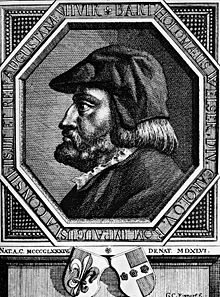
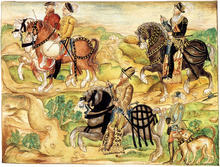
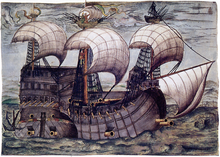
Bartholomeus V. Welser lent the Emperor Charles V a great sum of money for which, in 1528, he received as security the Province of Venezuela, developing it as Klein-Venedig (little Venice), but in consequence of their rapacious acts, the Welsers were deprived of their rule before the Emperor's reign was over.[citation needed] His son, Bartholomeus VI. Welser, explored Venezuela along with Philipp von Hutten and both were executed at El Tocuyo by local Spanish Governor Juan de Carvajal in 1546.
From 1528 to 1556, seven entradas (expeditions) led to the plunder and exploitation of local civilizations, but these colonial foundations led to future trade within the Americas. The first governors of Venezuela, Ambrosius Alfinger (1529–1533), Nicolas Federmann, and Georg von Speyer captured and enslaved local amerindians after their failed attempts to find gold on the Venezuelan coast. The Welsers contributed to the establishment of cities such as Coro, Maracaibo, and Bogotá.[5]
Caribbean slave trade[edit]
The Welser's hold of the slave trade in the Caribbean began in 1523, as they had begun their own sugar production in Santo Domingo. According to historian Julia Roth, “In 1532, the company purchased the sugar mill Santa Bàrbara in the department of San Juan de la Maguana through the Welser's overseas agent Sebastian Renz from Ulm for the price of 3427 Pesos, 202 Arrobas sugar, and 4 slaves.”[5] Slaves were notably listed in the same category as animals, signaling the early dehumanization of African enslaved workers. Over the next 15 years, thousands of enslaved Africans were transported to the Americas.
Habsburg marriage[edit]
Bartholomäus's niece, Philippine (1527–80), daughter of Franz Welser, was renowned for her learning and beauty. She secretly married the Archduke Ferdinand, second son of the Emperor Ferdinand I. She was given the titles Baroness of Zinnenburg, Margravine of Burgau, Landgravine of Nellenburg, and Countess of Oberhohenberg and Niederhohenberg. Their children were debarred from inheriting their father's rank as Archdukes of Austria; their son Margrave Andrew of Burgau became a cardinal and Charles, Margrave of Burgau became a noted general.
Other members[edit]
Another member of the Welser family, Markus Welser (1558–1614), was famed for his learning. He was a humanist, historian, publisher, and (from 1611) mayor of Augsburg.
Carl Wilhelm Welser von Neunhof (1663–1711) was a mayor of Nuremberg.
Branches and nobility[edit]
Bartholomeus V. Welser was ennobled by the Emperor in 1532. The Augsburg main line became extinct in 1797, the Nuremberg branch in 1878. The Ulm branch, who became Imperial Barons in 1713, still exists.[7] The Welsersche Familienstiftung (in English, the "Welser Family Foundation"), founded on 1 April 1539, still exists and has owned numerous castles in Germany. Following the extinction of the more senior lines of the family, the Ulm branch became administrators of the foundation.
Legacy[edit]
In Augsburg, a museum of Welser and Fugger history is planned (Fugger und Welser Erlebnismuseum).[8][9]
References[edit]
- ^ F. Roth: "Welser." In: Allgemeine Deutsche Biographie (ADB). Vol. 41, Duncker & Humblot, Leipzig 1896, pp. 682–692.
- ^ One or more of the preceding sentences incorporates text from a publication now in the public domain: Gilman, D. C.; Peck, H. T.; Colby, F. M., eds. (1905). . New International Encyclopedia (1st ed.). New York: Dodd, Mead.
- ^ Montenegro, Giovanna (2018). ""The Welser Phantom": Apparitions of the Welser Venezuela Colony in Nineteenth- and Twentieth-Century German Cultural Memory" (PDF). Transit. 11 (2): 36. doi:10.5070/T7112038255.
- ^ a b One or more of the preceding sentences incorporates text from a publication now in the public domain: Chisholm, Hugh, ed. (1911). "Welser". Encyclopædia Britannica. Vol. 28 (11th ed.). Cambridge University Press. p. 516.
- ^ a b c d Roth, Julia (2017). "Sugar and Slaves: The Augsburg Welser as Conquerors of America and Colonial Foundational Myths" (PDF). Atlantic Studies. 14:4 (4): 436–449. doi:10.1080/14788810.2017.1365279. S2CID 165476141.
- ^ Ibid., 442.
- ^ Chisholm 1911.
- ^ "Home |". Archived from the original on 2013-04-04. Retrieved 2013-04-15.
- ^ Krogull, Ute. "Museum für die Fugger und Welser". Augsburger Allgemeine.
Literature[edit]
- Urs Bitterli: Die Entdeckung Amerikas. Von Kolumbus bis Alexander von Humboldt; Beck'sche Reihe 1322; München: Beck, 1999, 544 Seiten, ISBN 3-406-42122-9
- Hartmut Bock: Die Familiengeschichtsschreibung der Welser, in: Mitteilungen des Vereins für Geschichte der Stadt Nürnberg (MVGN), 95 (2008), S. 93–162
- Johannes Burkhardt: Die Welser-Vöhlin-Gesellschaft. Fernhandel, Familienbeziehungen und sozialer Status an der Wende vom Mittelalter zur Neuzeit, in: Wolfgang Jahn u.a. (Hg.): Geld und Glaube. Leben in evangelischen Reichsstädten. Katalog zur Ausstellung im Antonierhaus, Memmingen 12. Mai bis 4. Oktober 1998; Veröffentlichungen zur Bayerischen Geschichte und Kultur 37/98; München 1998; S. 17–37
- Jörg Denzer: Die Konquista der Augsburger Welser-Gesellschaft in Südamerika (1528–1556). Historische Rekonstruktion, Historiographie und lokale Erinnerungskultur in Kolumbien und Venezuela; Schriftenreihe zur Zeitschrift für Unternehmensgeschichte 5; zugleich: Dissertation Universität Freiburg (Breisgau), 2003; München: Beck, 2005; ISBN 3-406-53484-8 (Leseprobe)
- Michael Diefenbacher (2000), Michael Diefenbacher, Rudolf Endres (ed.), Welsersche Handelsgesellschaft, Nuremberg City Lexicon (Stadtlexikon Nürnberg) (in German) (2nd, revised ed.), Nuremberg: W. Tümmels Verlag, pp. 1171 f., ISBN 3-921590-69-8
- Walter Großhaupt: Die Welser als Bankiers der spanischen Krone; in: Scripta Mercaturae, Zeitschrift für Wirtschafts- und Sozialgeschichte 21 (1987), S. 158
- Mark Häberlein, Johannes Burkhardt (Hrsg.): Die Welser. Neue Forschungen zur Geschichte und Kultur des oberdeutschen Handelshauses; Colloquia Augustana 16; Berlin: Akademie-Verlag, 2002; ISBN 3-05-003412-2
- Ursula Koenigs-Erffa: Das Tagebuch des Sebald Welser aus dem Jahre 1577; in: Mitteilungen des Vereins für Geschichte der Stadt Nürnberg (MVGN) 46 (1955); S. 262–371, auch online
- Johann Michael Frhr. v. Welser: Die Welser, Nürnberg 1917, Selbstverlag der Welserschen Familienstiftung,
